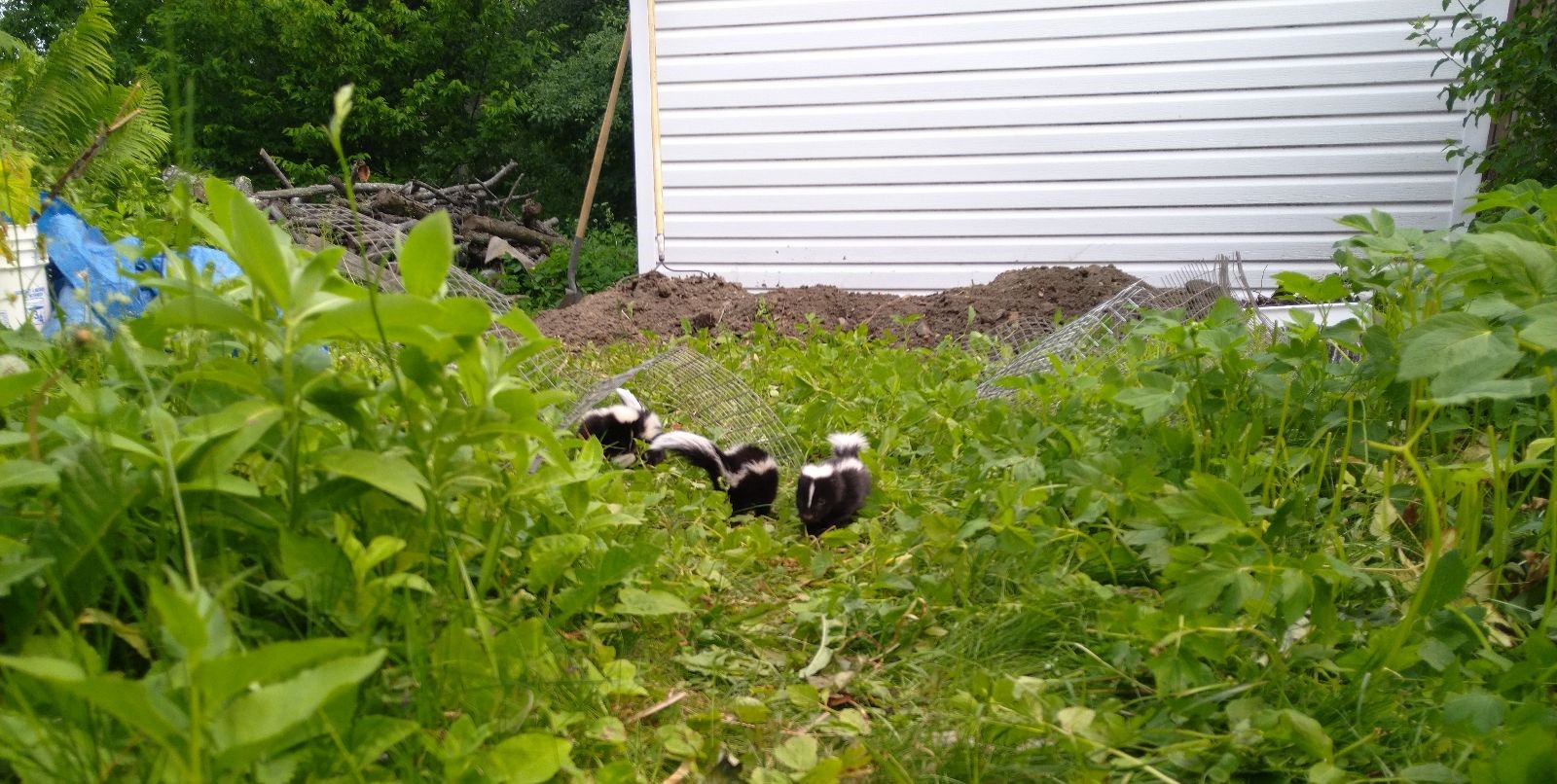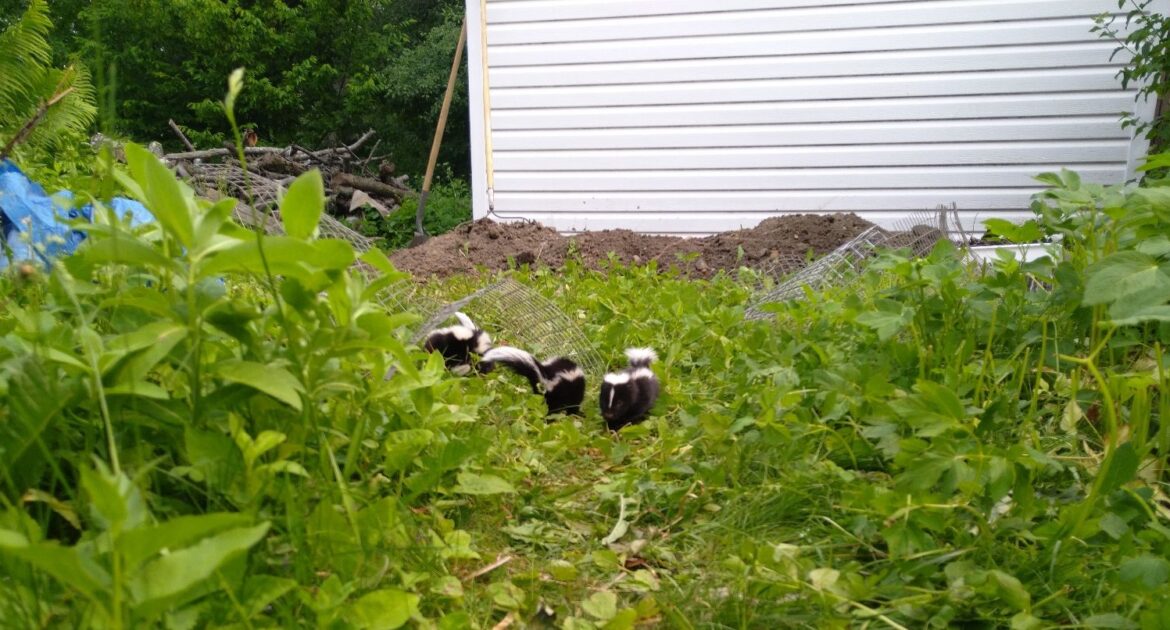Understanding skunk and raccoon behaviors is essential for homeowners in Hennepin County, particularly those in the Brooklyn Park area. These nocturnal creatures share our neighborhoods, emerging as darkness falls to begin their nightly routines.
At Skedaddle Minnesota, we’ve witnessed firsthand how these intelligent mammals adapt to urban environments and interact with our properties. From foraging to denning, by gaining insight into their behaviors, you can better protect your home and coexist more peacefully with these wild neighbors.
The Mysterious Nocturnal World of Skunks and Raccoons
When the sun sets over Brooklyn Park, a different world awakens. Skunks and raccoons are primarily nocturnal, meaning they conduct most of their activities under the cover of darkness. This evolutionary adaptation helps them avoid predators and human activity, but it also means their behaviors often go unnoticed until problems arise.
Nocturnal Activity Patterns
Skunks typically emerge from their dens shortly after dusk, with peak activity occurring during the first few hours of darkness. Raccoons may become active at sunset and remain on the move until early morning hours. Both animals adjust their nighttime schedules seasonally, extending their foraging time during the summer to take advantage of abundant food sources while reducing activity in winter. It’s particularly common for raccoons to den for days during extreme cold spells. Weather conditions, such as rain, wind, and temperature, also affect when and how long these animals remain active. Light rain rarely deters either species, but heavy downpours may drive them to seek shelter temporarily.
Understanding these patterns can help homeowners anticipate when they might encounter these animals or notice signs of their activity around their property. This knowledge is particularly valuable for residents near natural areas in Hennepin County, where wildlife interactions are more common.
Nighttime Habits of Skunks: More Than Just Spray
Skunks are often defined by their defensive spray capability, but their nighttime habits reveal more complex behaviors. These small mammals are methodical in their movements and surprisingly predictable once you understand their motivations.
Foraging Behaviors
Skunks are natural excavators, using their powerful front claws and keen sense of smell to locate food. During nighttime hours, you might notice small, cone-shaped holes in your lawn, clear signs of skunks digging for grubs and insects, their preferred food source. Skunks exhibit systematic patterns, often working in a linear fashion across your yard, methodically searching for food rather than digging randomly. If a skunk finds your yard to be a productive feeding ground, it will likely return night after night, following similar paths and timing. Freshly watered lawns, gardens, and areas under bird feeders are particularly attractive to skunks due to the concentration of insects, fallen seeds, and soft soil for digging.
Denning Behaviors
Unlike their foraging habits, skunks prefer stability when it comes to shelter. They don’t wander far from their dens and will defend these spaces, particularly when raising young. Preferred den sites include decks, porches, sheds, and concrete slabs, as the cavities beneath these structures offer protection from predators and extreme weather. Using their digging abilities, skunks can move several hundred pounds of soil in a single night to create a suitable den, potentially compromising the structural integrity of the above-ground area. Skunks leave scent markers around their territory using glands located at the base of their tail to establish boundaries with other skunks in the area.
We’ve observed that once skunks establish a den under a structure in Brooklyn Park homes, they become quite attached to the location. This makes professional, humane removal even more important before they settle in for extended periods.
Raccoon Nocturnal Activity: Masters of Adaptation
Raccoons display remarkable intelligence and adaptability in their nighttime activities. Unlike the methodical approach of skunks, raccoons are curious explorers constantly seeking new opportunities.
Urban Foraging Techniques
Raccoons have adapted incredibly well to human environments, developing specialized behaviors to exploit our resources. Their highly sensitive front paws allow them to open containers and manipulate complex objects like garbage can latches. Raccoons remember successful feeding locations and techniques, returning to productive sites night after night with increasingly refined approaches. While not strictly social animals, raccoons in urban areas like Brooklyn Park sometimes forage in loose groups, particularly around abundant food sources. Unsecured trash cans, pet food left outdoors, bird feeders, and compost piles are prime attractions for raccoons in residential areas.
Movement and Communication
Raccoons establish complex travel routes through neighborhoods that maximize efficiency and safety:
- Overhead pathways: These animals use tree branches, fences, and utility lines to travel, creating “highways” above ground level to move safely between feeding areas.
- Consistent timing: Raccoons often follow reliable schedules, visiting the same locations at similar times each night.
- Vocal communication: They use over 200 different vocalizations to interact with each other, from chatters and growls to the familiar trilling purr that indicates contentment.
While raccoons may share territory, they maintain a loose hierarchy, with dominant individuals gaining preferential access to food sources and den sites. In our experience at Skedaddle Minnesota, raccoons in the Hennepin County area have become increasingly adept at exploiting structural vulnerabilities in homes, with roof intersections and soffit areas being particularly common entry points.
When Worlds Collide: Skunk and Raccoon Interactions
While both species are nocturnal and may share territories, their interactions reveal fascinating behavioral dynamics. Understanding these interactions can help homeowners anticipate potential wildlife issues.
Territorial Overlap
Skunks and raccoons can occupy the same general area but typically maintain different niches. Though both species are omnivorous, skunks focus more on insects and grubs, while raccoons prefer fruits, nuts, and human food waste, reducing direct competition. Even within the night hours, peak activity times often differ, with skunks typically more active in early evening and raccoons in the middle of the night. When direct competition occurs, raccoons typically defer to skunks due to the threat of spraying, despite being larger and stronger.
Seasonal Behavioral Changes
Both animals modify their behavior during Minnesota’s distinct seasons, impacting when and how they might interact with your property:
- Spring (April-June): Both species give birth and raise young. Mother skunks become highly territorial around den sites, while female raccoons seek elevated den locations for their kits.
- Summer (June-August): Young of both species begin exploring with parents, learning foraging techniques. This is when homeowners in Brooklyn Park most frequently notice increased activity.
- Fall (September-November): Both animals enter a period of hyperphagia—intensive feeding to build fat reserves for winter. They become bolder in their foraging efforts during this time.
- Winter (December-March): Activity reduces significantly. Skunks enter a state of torpor (not true hibernation) in their dens, while raccoons may den together for warmth during the coldest periods.
These seasonal patterns directly impact the potential for wildlife encounters in your property, with fall being a particularly critical time for preventative measures.
Signs of Unwelcome Visitors
Recognizing the evidence of skunk and raccoon activity early can help prevent more serious conflicts. With skunks, you might notice cone-shaped holes in your lawn, while raccoons often leave overturned trash cans and missing pet food as their marks.
Taking immediate action upon noticing these signs can help prevent these nocturnal creatures from causing further damage. If you’re facing challenges with skunks or raccoons in your property, don’t wait until these nocturnal visitors become a larger problem. Reach out to Skedaddle Minnesota for effective and humane wildlife management solutions tailored to protect your home and help maintain a peaceful coexistence with local wildlife.




